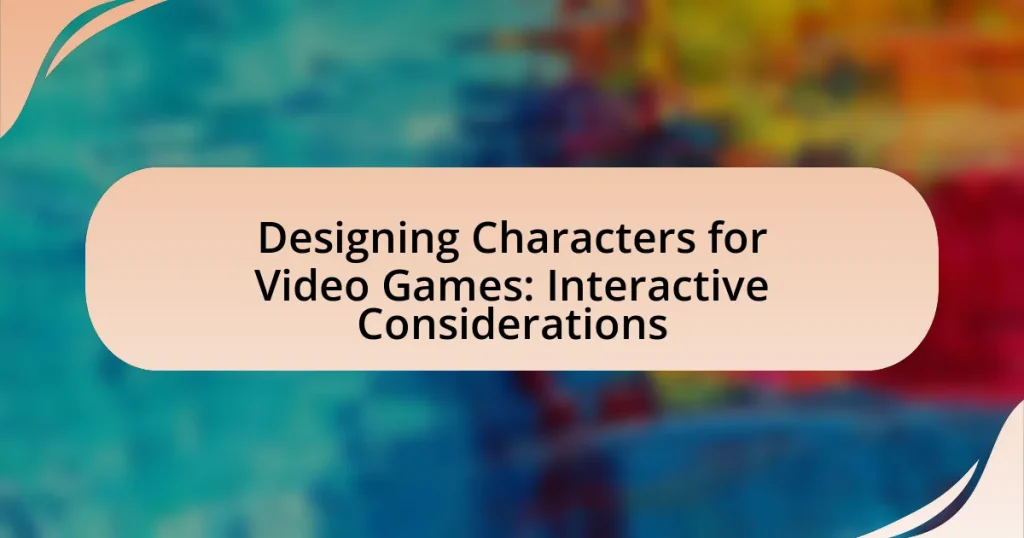The article focuses on the principles of designing characters for video games, emphasizing clarity of design, emotional resonance, functionality, and adaptability. It explores how character designs influence player engagement through visual elements, backstory, and personality traits, highlighting the importance of interactivity and player choices in character development. Additionally, it discusses best practices for creating memorable characters, the significance of diversity, and common pitfalls to avoid in character design. The article underscores the integration of game mechanics with character design and the impact of customization on player experience, providing insights into effective strategies for enhancing character design in video games.

What are the key principles of designing characters for video games?
The key principles of designing characters for video games include clarity of design, emotional resonance, functionality, and adaptability. Clarity of design ensures that characters are visually distinct and easily recognizable, which aids player identification and engagement. Emotional resonance involves creating characters with relatable traits and backstories that evoke empathy, enhancing player connection. Functionality refers to how well a character’s design supports gameplay mechanics, ensuring that their abilities and appearance align with their role in the game. Adaptability allows characters to evolve throughout the game, reflecting player choices or narrative developments, which keeps the experience dynamic and engaging. These principles are supported by industry practices, such as the use of character archetypes and iterative design processes, which have been shown to improve player satisfaction and immersion in titles like “The Legend of Zelda” and “The Last of Us.”
How do character designs influence player engagement?
Character designs significantly influence player engagement by shaping emotional connections and enhancing immersion. Well-crafted characters with distinct visual styles, relatable traits, and compelling backstories can evoke empathy and investment from players, leading to deeper involvement in the game. Research indicates that players are more likely to engage with games that feature characters they find visually appealing and relatable, as these elements can trigger emotional responses and foster a sense of attachment. For instance, a study published in the journal “Computers in Human Behavior” found that players reported higher levels of enjoyment and emotional engagement when interacting with characters that displayed unique and well-defined personalities. This demonstrates that effective character design is crucial for maximizing player engagement in video games.
What visual elements are crucial in character design?
Crucial visual elements in character design include silhouette, color palette, and facial features. The silhouette defines the character’s overall shape and helps in creating a memorable and recognizable figure, which is essential for player identification. The color palette influences the character’s personality and emotional tone, guiding player perception and engagement. Facial features convey emotions and traits, allowing players to connect with the character on a deeper level. These elements collectively enhance the character’s appeal and functionality within the interactive environment of video games.
How does character backstory affect design choices?
Character backstory significantly influences design choices by providing context that shapes visual elements, personality traits, and gameplay mechanics. For instance, a character with a traumatic past may be designed with darker color palettes and rugged features to reflect their struggles, while a character with a noble background might exhibit brighter colors and refined aesthetics. This alignment between backstory and design enhances player immersion and emotional connection, as players can relate to the character’s experiences through their visual representation. Research indicates that cohesive character design, which integrates backstory elements, leads to a more engaging player experience, as seen in titles like “The Last of Us,” where character histories directly inform their design and interactions.
What role does character personality play in design?
Character personality plays a crucial role in design by influencing how players perceive and interact with characters in video games. A well-defined personality shapes a character’s behavior, dialogue, and visual aesthetics, creating a more immersive experience. For instance, research indicates that players are more likely to engage with characters that exhibit relatable traits, as these traits foster emotional connections and enhance gameplay satisfaction. This connection is supported by studies showing that characters with distinct personalities can significantly impact player choices and overall game enjoyment, as evidenced by the success of narrative-driven games like “The Last of Us,” where character depth is integral to the storytelling experience.
How can personality traits be visually represented?
Personality traits can be visually represented through character design elements such as color schemes, facial expressions, body language, and clothing styles. For instance, bright colors may indicate a cheerful personality, while darker tones might suggest a more serious or introverted character. Research in psychology supports this visual representation; studies show that color can evoke specific emotional responses, influencing how personality traits are perceived. Additionally, body language, such as posture and gestures, can convey confidence or anxiety, further enhancing the visual portrayal of a character’s personality.
What are the implications of character archetypes in design?
Character archetypes in design significantly influence player engagement and narrative coherence in video games. These archetypes serve as recognizable templates that help players quickly understand character motivations and roles, enhancing their emotional connection to the story. For instance, the Hero archetype often embodies traits like bravery and selflessness, which can drive the narrative forward and encourage players to invest in the character’s journey. Research by Vogt et al. (2019) in “The Role of Character Archetypes in Video Game Narratives” highlights that games utilizing clear archetypes tend to achieve higher player satisfaction and immersion, as players can easily relate to familiar character dynamics. Thus, the implications of character archetypes extend to shaping gameplay experiences and fostering deeper player involvement.

How does interactivity shape character design in video games?
Interactivity significantly shapes character design in video games by influencing how characters are developed to respond to player actions and choices. This dynamic requires designers to create characters with adaptable traits, allowing for varied interactions that enhance player engagement. For instance, games like “The Witcher 3” feature characters whose personalities and story arcs change based on player decisions, demonstrating that interactivity necessitates a more complex and responsive character design. This approach not only enriches the narrative experience but also fosters a deeper emotional connection between players and characters, as evidenced by player feedback and engagement metrics in interactive storytelling games.
What are the interactive elements that influence character design?
Interactive elements that influence character design include player agency, feedback systems, and environmental interactions. Player agency allows users to make choices that affect character development, which can lead to diverse design adaptations based on player preferences. Feedback systems, such as visual and auditory cues, inform players about their actions and the character’s status, guiding design decisions to enhance engagement. Environmental interactions, including how characters respond to their surroundings, shape design elements to ensure realism and immersion. These factors collectively inform character design strategies in video games, ensuring that characters resonate with players and enhance the overall gaming experience.
How do player choices affect character development?
Player choices significantly influence character development by determining the traits, skills, and narrative arcs that characters experience throughout the game. In interactive video games, decisions made by players can lead to different outcomes, shaping the character’s personality and relationships with other characters. For instance, a player who consistently chooses to act compassionately may develop a character with high empathy and strong alliances, while a player who opts for aggressive choices may create a character that is feared and isolated. This dynamic is supported by research indicating that player agency enhances emotional investment and engagement, as seen in titles like “Mass Effect” and “The Witcher,” where choices lead to distinct character paths and endings.
What is the impact of character customization on player experience?
Character customization significantly enhances player experience by fostering a sense of ownership and personal connection to the game. When players can tailor their characters’ appearance, abilities, and traits, they are more likely to engage deeply with the game world, leading to increased immersion and satisfaction. Research indicates that personalized avatars can improve emotional investment, as players often feel more represented and connected to characters that reflect their preferences or identities. For instance, a study published in the journal “Computers in Human Behavior” found that players who customized their avatars reported higher levels of enjoyment and a stronger sense of agency within the game. This customization not only enriches gameplay but also encourages social interaction, as players often share their unique creations, further enhancing community engagement.
How do game mechanics integrate with character design?
Game mechanics integrate with character design by ensuring that a character’s abilities, traits, and visual elements align with the gameplay experience. For instance, a character designed for a stealth game may possess abilities like silent movement and camouflage, which directly influence how players interact with the game world. This alignment enhances immersion and gameplay fluidity, as players can intuitively understand how to utilize the character’s strengths within the mechanics of the game. Additionally, characters often embody specific mechanics, such as health regeneration or special powers, which are visually represented through their design, reinforcing the connection between their appearance and gameplay functionality.
What types of gameplay styles require different character designs?
Different gameplay styles require distinct character designs to enhance player experience and engagement. For instance, role-playing games (RPGs) often necessitate detailed character designs that reflect the character’s background, abilities, and personality, allowing players to immerse themselves in the narrative. In contrast, platformers typically utilize simpler, more exaggerated designs to emphasize movement and agility, facilitating quick recognition and response during gameplay. Additionally, first-person shooters (FPS) may prioritize realistic character designs to enhance immersion and tactical gameplay, while fighting games often feature unique, stylized characters that highlight individual fighting styles and abilities. These variations in character design are essential to align with the mechanics and objectives of each gameplay style, ensuring that players can easily connect with and navigate their in-game experiences.
How can character abilities be visually communicated?
Character abilities can be visually communicated through distinct visual cues such as color coding, animations, and iconography. For instance, a character’s health or mana can be represented by specific colors—red for health and blue for mana—allowing players to quickly assess their status. Animations, such as a character glowing or changing posture when using an ability, provide immediate visual feedback on the action being performed. Additionally, icons that represent abilities can be displayed on the user interface, offering a clear and concise way to inform players about available skills and their effects. These methods enhance player understanding and engagement by providing intuitive visual representations of character capabilities.

What are the best practices for creating memorable video game characters?
The best practices for creating memorable video game characters include developing a strong backstory, ensuring distinct visual design, and providing unique personality traits. A well-crafted backstory gives depth and motivation, making characters relatable and engaging; for example, characters like Lara Croft from Tomb Raider have rich histories that enhance player connection. Distinct visual design, such as the iconic look of Mario with his red hat and mustache, helps characters stand out and become easily recognizable. Unique personality traits, like the humor of Claptrap from Borderlands, create memorable interactions that resonate with players. These elements combined contribute to a character’s lasting impact in the gaming community.
How can designers ensure characters resonate with players?
Designers can ensure characters resonate with players by creating relatable backstories and emotional depth. When characters possess well-developed narratives that reflect real human experiences, players are more likely to connect with them on a personal level. Research indicates that players engage more deeply with characters who exhibit traits such as vulnerability, ambition, or moral dilemmas, as these elements mirror their own life challenges. For instance, a study by the University of Southern California found that players reported higher emotional engagement with characters who faced relatable struggles, enhancing their overall gaming experience.
What techniques can be used to create relatable characters?
To create relatable characters, developers can employ techniques such as deep character backstories, realistic dialogue, and emotional arcs. Deep character backstories provide context and motivation, allowing players to understand characters’ actions and decisions, which fosters empathy. Realistic dialogue enhances authenticity, making interactions feel genuine and relatable. Emotional arcs, where characters experience growth or change, resonate with players, as they reflect real-life experiences and struggles. These techniques are supported by research indicating that players engage more deeply with characters who exhibit complexity and emotional depth, enhancing their overall gaming experience.
How important is diversity in character design?
Diversity in character design is crucial as it enhances representation and relatability in video games. Diverse characters allow players from various backgrounds to see themselves reflected in the game, fostering a sense of inclusion and connection. Research indicates that games featuring diverse characters can lead to increased player engagement and satisfaction, as players are more likely to invest emotionally in stories that resonate with their own experiences. For instance, a study by the International Game Developers Association found that 70% of players prefer games with diverse character options, highlighting the demand for inclusivity in character design.
What common pitfalls should be avoided in character design?
Common pitfalls to avoid in character design include lack of originality, inconsistent visual style, and neglecting character backstory. Originality is crucial; characters that resemble existing ones can lead to unengaging gameplay and player disinterest. Inconsistent visual style can confuse players and detract from immersion, as characters should align with the game’s overall aesthetic. Additionally, neglecting character backstory can result in shallow characters that fail to resonate with players, as a well-developed backstory enhances emotional connection and player investment.
How can stereotypes be avoided in character creation?
Stereotypes can be avoided in character creation by ensuring diverse representation and depth in character backgrounds. This involves conducting thorough research on different cultures, experiences, and perspectives to create well-rounded characters that reflect individuality rather than clichés. For instance, a study by the Geena Davis Institute on Gender in Media highlights that diverse representation leads to more authentic storytelling and audience engagement. By prioritizing character development that emphasizes unique traits and personal narratives, creators can effectively move away from harmful stereotypes.
What are the consequences of neglecting character development?
Neglecting character development in video games leads to shallow narratives and disengaged players. When characters lack depth, players struggle to form emotional connections, resulting in diminished investment in the game’s story and outcomes. Research indicates that well-developed characters enhance player immersion and satisfaction, as seen in successful titles like “The Last of Us,” where character arcs significantly contribute to the overall experience. Without character development, games risk becoming forgettable and fail to resonate with audiences, ultimately impacting sales and player retention.
What tips can enhance character design for video games?
To enhance character design for video games, focus on creating unique silhouettes and distinct color palettes. Unique silhouettes help characters stand out and are easily recognizable, which is crucial in gameplay where quick identification is necessary. Distinct color palettes can convey personality traits and emotional states, enhancing player connection. Research indicates that characters with strong visual identities lead to better player engagement and retention, as seen in successful franchises like “Overwatch” and “Fortnite,” where character design plays a pivotal role in their popularity.


